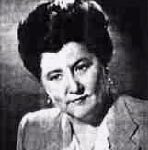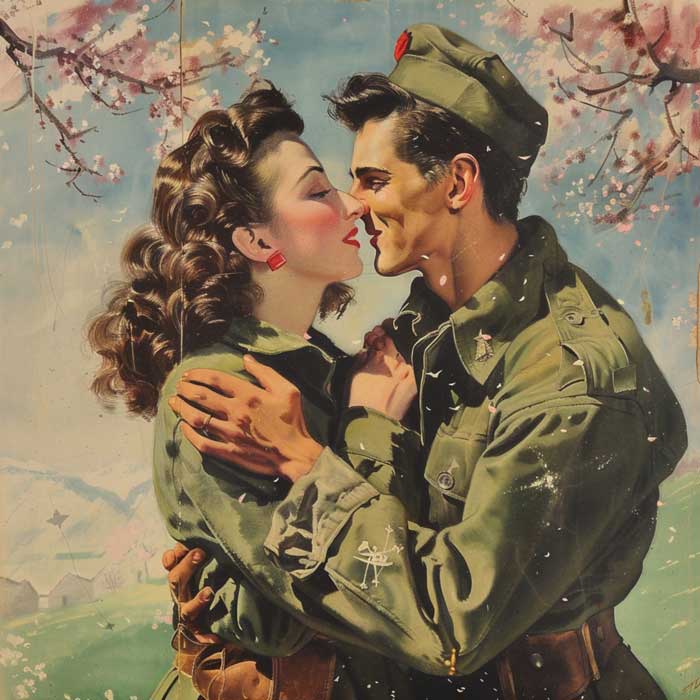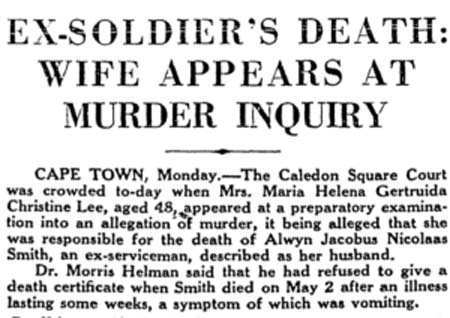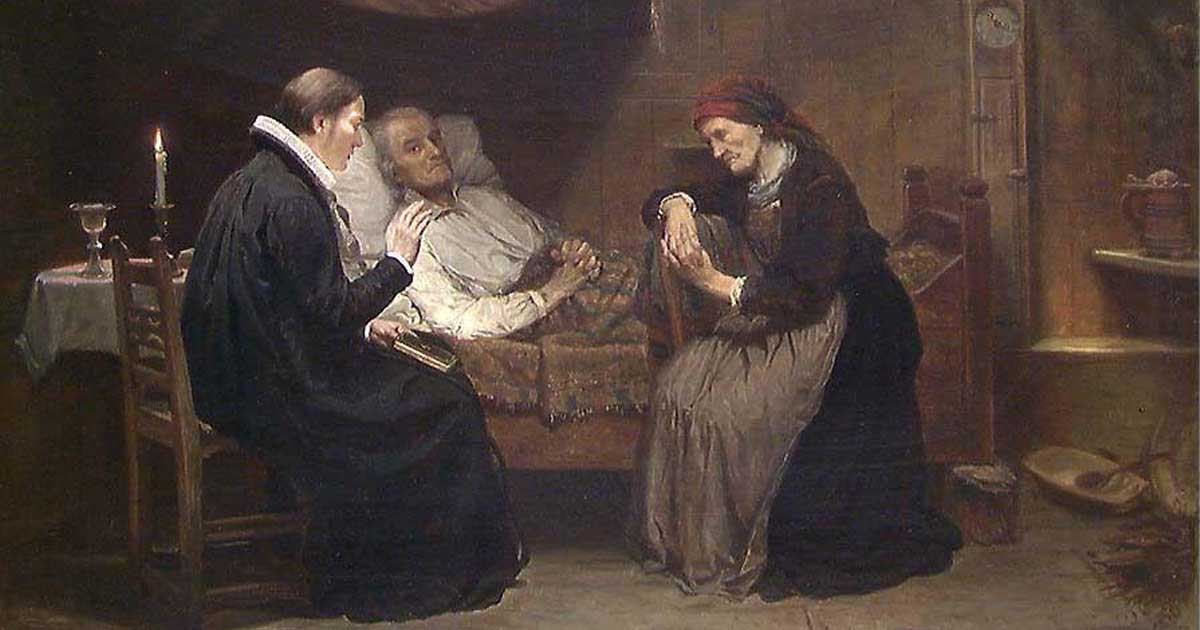Besides both being regarded as infamous poisoners Catherine Montvoisin, colloquially known as La Voisin, a key figure in the 17th century-Affair des Poisons in France, and Maria Lee, a notorious murderer in post-Second World War South Africa, had several traits in common. Although neither were attractive, they both had a certain sensual allure, that ‘bewitched’ men – La Voisin even attracted many lovers including sorcerers and alchemists. Both Maria and La Voisin were promiscuous.
Since many aristocrats queued up for her services to buy potions and poisons, La Voisin was quite a wealthy woman and profited not only from the death of her clients’ rivals, lovers and husbands, but also from trading in aborted babies to be sacrificed in Black Masses.


Maria Lee, the Matronly Murderess
Contemporary newspaper reports described her Maria Lee as ‘highly sexed, much married or possessed, extremely money-conscious, cruel, callous, implacable and unmoved by the suffering of her victim’. But behind her frumpy appearance, lurked a lethally keen and scheming mind. Her life fascinated South Africans in a post-Second World War era.
She was born Maria Helena Gertruida Christina van Niekerk in 1899 and was married at the age of sixteen in 1915 to Daniel Oosthuizen, twice her age. The couple had four sons. By 1941 Maria had divorced Oosthuizen, married and divorced a Mr Kruger, engaged in several short-term affairs and married her third husband 24-year-old Jan de Klerk Lee, who died of tuberculosis. At the age of 42, Maria inherited his comfortable estate amounting to £3000. Since her birth, Maria had lived through three wars: the Boer War, and the First and Second World Wars, but like La Voisin, she set out capitalize and make a profit by buying and selling properties, she ran a stolen jewellery scam and she benefited from the deaths of her husbands.

In the post war-era she double-crossed two lovers, one was a soldier, a certain CJB Oliver, with whom she had corresponded during the war and married him in Pretoria when he returned home from the Northern front. They moved to Bethlehem, a town in the Free State. Unbeknown to Oliver, Maria had in the meantime set up home in Cape Town with Alwyn Smith, half her age, and they lived as husband and wife. Apparently, Alwyn was not very intelligent, but his handsome features and vigorous sexual appetite made up for it and he found the 46-year-old Maria very alluring.
Maria was working at American Swiss Watch Company in Cape Town, but she regularly managed to mislead both men by alternating between her two homes in Cape Town and Bethlehem, having them believe she was attending to her many business interests. Whenever she was away from one of them, she engaged in passionate correspondence. Maria had rented a private mailbox in Pretoria. She had arranged with a friend to forward her letters from Alwyn to Bethlehem and she would also send her letters to the friend in Pretoria, who forwarded them to unsuspecting Alwyn in Cape Town. She used the same modus operandi with her letters to Oliver in Bethlehem when she was in Cape Town.
Alwyn found employment in Durban and Maria used his relocation as an opportunity to send him jewellery she had stolen from American Swiss to fleece in Durban. While Alwyn was on leave in Cape Town, Maria pleaded with him to return to Durban only to resign and to move back to Cape Town. Maria had given Alwyn cash to buy a brand-new car, as well as an expensive watch to convince him.
Alwyn left for Durban on 23 October 1943, but fell seriously ill on the train. He was admitted to a hospital in Durban, where he recovered, but the moment he returned home to Cape Town, he contracted the terrible stomach cramps again. His physician, Dr Helman was confounded by the symptoms. He was even more surprised when Alwyn told him, in the presence of Maria, that he no longer required him as his physician. For a while, Maria was the only person who attended to Alwyn.
Meanwhile, Mr Oliver was unhappy with his wife being out of town so often and threatened to divorce her if she did not return to the Free State. Luckily for him, Maria agreed to the divorce. Alwyn, whose estate amounted to about R15, 000 was not so lucky.
On the morning of 2 May 1947, Maria phoned Dr Helman, informing him her husband was dying. Dr Helman hastened to the apartment on his own accord. He found a dying Alwyn and a very concerned Maria. A few minutes later Alwyn passed away. Dr Helman refused to issue a death certificate, which upset Maria. He went to the Caledon Square Police Station in Cape Town central and asked the police to transport the body to a mortuary for a postmortem. Two constables were dispatched to the apartment where they found a bereaved Maria kissing the feet of her dead “husband”. Dr Keen, State pathologist, decided to send tissue samples of Alwyn to Johannesburg for analysis. Two months later, Dr Keen received the results: Alwyn had died due to arsenic poisoning. Colonel Fred van Niekerk was appointed to investigate.
Colonel Fred visited the apartment, to find Maria wearing dark glasses in bed. She was distraught at the death of her “husband”. With her permission they searched the apartment and confiscated Alwyn’s pocketbook. He also established that Alwyn had left a substantial estate, of which Maria was the sole beneficiary. The money consisted mainly of bonds. The car and watch were specifically mentioned in the will. Fred interviewed Mrs Sarah Jacobs, the landlady who informed him that Maria had requested her and a friend to sign Alwyn’s will as witnesses. They refused to sign unless they were in his presence. A clerk of the pharmacy where Maria had previously worked also informed Fred that Maria had brought the will, written in her handwriting and requested him to type it. When Fred read the poison registers of this pharmacy, he found that Alwyn Smith had bought rat poison on 14 January 1947. Maria had sent her lover to buy the poison she had used for his own death, much the same modus operandi as Amy Archer Gilligan used for the lodgers in her boarding house in Connecticut, a few years prior.
Fred also established that Maria had requested the body to be cremated, but the request was refused. She then asked for it to be embalmed. At that time, she did not know that the State pathologist had already sent samples for analysis to Johannesburg. Sarah, the landlady also informed Fred that Maria had begun an affair with one’s of Alwyn’s friends, shortly after his death.
Fred phoned the telephone number of Mr Freddie Moorgas that he had found in Alwyn’s pocketbook. Freddie told Fred about the jewellery that Alwyn was selling in Durban and this was how Fred uncovered the stolen jewellery scam.

By October 1947, Fred had enough evidence to arrest Maria Lee for the murder of Alwyn Smith. Maria, in the meantime, had fled to Pretoria, but he arrested her in a hairdressing salon on 14 October 1947. By this time, Maria was already engaged to another man in Pretoria. While in custody in Pretoria Central Prison, Maria bribed a fellow cellmate, Magrieta to conjure up a story that she had known Alwyn in Durban, that he was a drunk and that he drank arsenic in a suicide attempt. As soon as Magrieta was released on bail she went to the police and told them what Maria had admitted to her. At that time there had been no newspaper reports that Alwyn had been poisoned with arsenic. Maria therefor had admitted to first-hand knowledge of the crime.
The trial commenced on 6 April 1948 at the Cape Town Supreme Court before Mr Justice Gabriel Steyn. Ladies queued the night before to secure a seat in court. Maria, dressed to the nine’s, with black ostrich feathers adorning her hair, put on a performance as the innocent, grieving widow. On 10 May 1948, Mr Justice Steyn commenced reading his judgement. A faint smile played on Maria’s face behind the black netting of her mantilla. “I can but come to the conclusion,” read Mr Justice Steyn, “that Mrs Lee never bore any love or affection for Alwyn Smith. The attempts to convince those who came in contact with them in their private lives, of her deep devotion and attachment for him, were a feigned and hollow mockery. If true love was absent and there is this continuous pretence of doing whatever she could for Smith during his illness, then it must have been a deliberate attempt at camouflage. The question is then: why did she so conduct herself? The answer is that she was carrying out a foul design and engaged in a series of acts of poisoning which led to the death of Alwyn Smith. For these reasons I have no alternative but to find her guilty as charged.” By the time he had finished, the alluring smile had vanished and the ragged face of the 48-year old murderess was revealed.

On 17 September 1948, Maria Lee was led to the gallows at Pretoria Central Prison. As the noose was placed over her head, she softly said: “Jesus” and seconds later, she died.
By what means did Maria and La Voisin for that matter, ‘bewitch’ men? That hold is called ‘allure’. The word ‘allure’ refers to the quality of being powerfully and mysteriously attractive or fascinating, the ability to powerfully attract or charm; to tempt. It may have positive or negative connotations.
Given that men are much more inclined to short-term non-monogamous affairs, Maria had no shortage in finding partners for her promiscuous engagements. Promiscuity is often found in women who have been abused as children, and serves as a manner by which they perceive they can regain their power over their own bodies and over men. There is no evidence that Maria was molested or sexually abused, but she was married at 16 to a man twice her age. By engaging in promiscuity, Maria had the opportunity to hone her seduction skills and it made her feel powerful. Maria Lee’s allure, and I suspect La Voisin’s as well, was firmly embedded in the fact that both of them embodied the Dark Triad Personality traits.
To know more, please join my Patreon community.
Top image: At the Death Bed by Adolph Tidemand (1860) (Public Domain)
